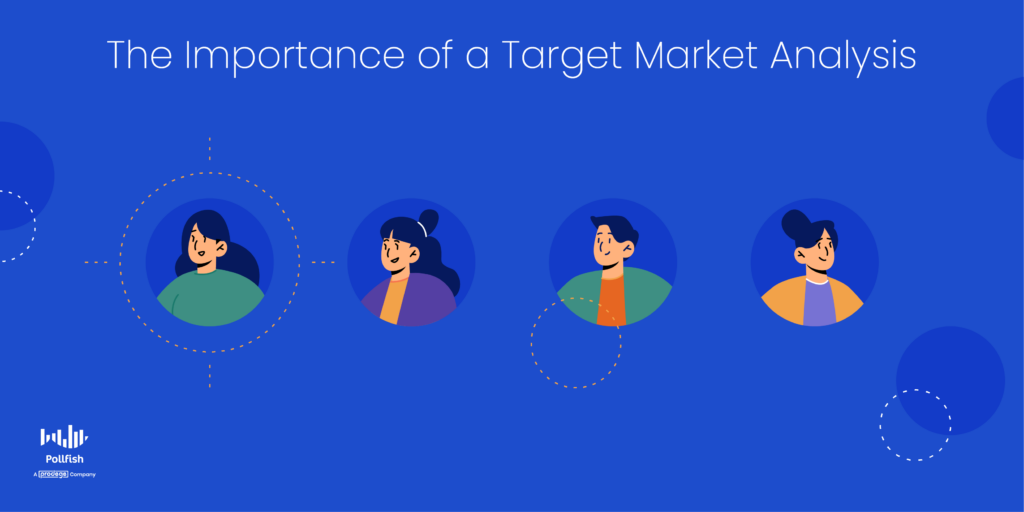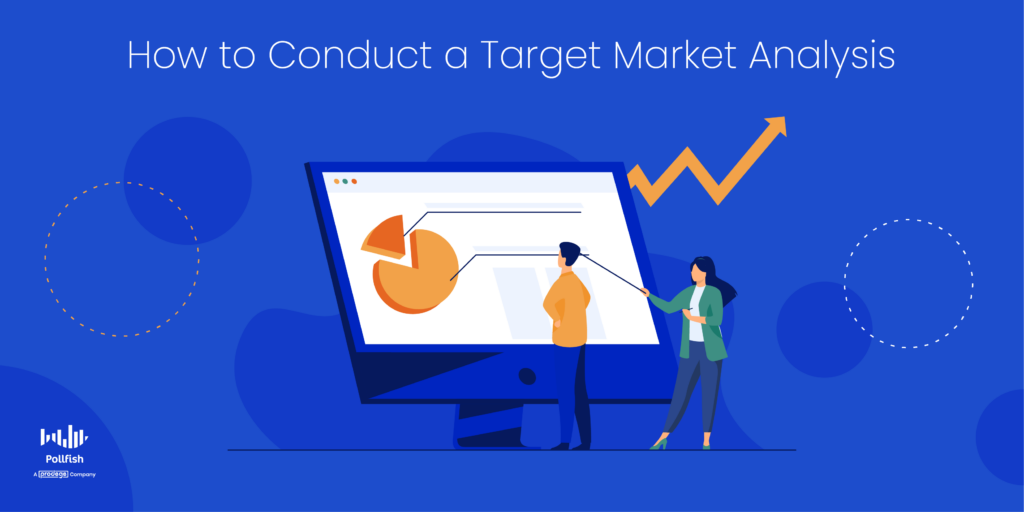Fully Understanding Your Consumers with a Target Market Analysis

Conducting a target market analysis is central to market research, as it enables you to understand your consumers in-depth and in relation to the viability of your products and services.
A vague or unproven idea of your target market — the group of customers most likely to patronize your business — will have damaging consequences for your business. This is because you can’t be all things to all people; even your competitors’ target market isn’t the exact same as yours.
Analyzing your consumers will help your business reach the right audience, along with a slew of other benefits. In fact, by segmenting your consumers through a target market analysis, you can increase profits by 80%.
This article examines the practice of the target market analysis, its importance, when to use it and how to create it using market research software.
Understanding the Target Market Analysis
A target market analysis is more than simply a study of your potential customers.
A target market analysis is a comprehensive assessment of your target market, the core base of customers most inclined to buy your product or service. One of several market research techniques, this kind of analysis is exhaustive in that it doesn’t merely examine customers.
Instead, this method involves assessing how your offerings will fit with a specific market and how they will achieve the most traction with your target customers. As such, a target market analysis defines where and how your product belongs in the real-life market.
Given that a target market analysis grants a high-level perspective of your market, you can use it to outline the opportunities and restraining factors that exist in your market.
Being able to create a market analysis will enable you to comprehend who to market and sell to along with how to satisfy your consumer preferences. As such, a target market analysis will help you reach your customers and provide them with a solution tailored to their specific needs or concerns.
When you conduct your target market analysis, you’ll need to consolidate your previously conducted demographic analysis with a psychographic analysis. These two kinds of analyses provide detailed information on the makeup of your target market, from their quantitative information, such as their age, gender, location, education and other such categories, to the psychological underpinnings of their buying habits and needs.
As such, this analysis requires merging both analyses, along with analyzing your own offerings and the problems they can solve for your target market.
The Importance of a Target Market Analysis
A target market analysis is critical to your organization for a number of reasons.
First off, businesses don’t have the time or resources to serve or reach everyone with a product offering and message. By analyzing a target market, you can focus on the correct audience, the kind most likely to need, want and purchase your product or service.
As such, you can work on campaigns directed at customers with the highest profit potential, or at least those who will purchase from you every now and again.
Furthermore, this analysis also helps you determine the least valuable target markets, so you can know which customers are worth pursuing and which are worth avoiding.

As such, this intelligence permits you to limit the populations you market to and serve. By limiting those populations, you will improve how you allocate funds to your market research budget and other business budgets. Thus, a target market analysis saves you time, money and other resources by informing you of the most beneficial means of funneling them.
Conducting a target market analysis also enables you to develop customer personas. These are highly defined and granular representations of particular individuals in your target market. They offer a hyper-specific form of the groups in your target market, which you would identify via market segmentation.
Understanding your customer personas allows you to understand your ideal customers more accurately and how to forge marketing personalization for them more effectively. Personalization is a crucial marketing strategy, as no one wants to feel marketed to, especially with mundane and generic messaging. In fact, 99% of marketers say personalization advances customer relationships and 80% of consumers are more likely to buy when brands offer personalized experiences.
In addition, a target market analysis helps you understand the viability of your products and services in relation to your target market. As such, you can use it to discover gaps in the market that your organization can fill. In this way, this analysis helps you work on product innovation and augmenting your customer experience.
This is because feedback from your target market helps you evaluate how successful your existing or new products will be, along with other insights on your CX.
This kind of analysis also unearths new target customers that are interested in your offerings, groups you previously may have been unaware of.
Finally, you can leverage your target market analysis to find the best marketing channels to use. This is important as various market segments use and respond differently to social media platforms. Some may forgo using a certain platform entirely, while others may get all their information from one social media platform.
All in all, analyzing your target market brings various benefits for your business, whether you’re a startup or a long-standing business.
When to Use a Target Market Analysis
There are several key times you should conduct and parse through a target market analysis. These will vary depending on the duration of your business, the particular campaign you set to work on, or one that is in the works, along with various other factors unique to your business.
The following lists some of the most opportune times to complete a target market analysis:
- When venturing into how to do market research for a business plan.
- During the early stages of a business.
- During certain stages of the strategic planning process that require more consumer insights.
- Before beginning a marketing, advertising, branding or other business campaigns.
- This is especially important, as money, time and creativity are often spent on these undertakings.
- During any major campaign, it is critical to be targeting the correct audience.
- If you seek to discover other customer segments and personas that may be interested in your product or service.
- When you need ideas on how to make product improvements and updates.
- This involves getting rid of bugs and glitches, along with optimizing the user experience of your products.
- If you seek to improve your digital experience or obtain feedback on it from all your market segments.
- This helps inform your content marketing strategy.
- During concept testing and A/B testing, to put customer opinions into perspective by understanding the preferences of all market segments.
How to Create a Target Market Analysis
You’ll need to consolidate several documents to run a comprehensive target market analysis. This will ensure you’re not missing any key insights about your customers and your product or service’s use to them.

The following provides step-by-step instructions for creating a target market analysis:
- First, decide the purpose of your analysis by using the previous section to guide you.
- There are various other instances that may require putting together this analysis, regardless of whether its purpose is mentioned in the prior section or not.
- Next, consolidate your demographic and psychographic analyses of your target market.
- These analyses have critical customer information that you’ll need to use in your target market analysis.
- Combine your findings by adding the psychographic information to the demographical information.
- For example, let’s say one of your segments is men and women in their mid-forties to early fifties. Add their behavioral, lifestyle and psychological factors you’ve uncovered in your psychographic analysis.
- Should you require more information, conduct secondary market research by observing resources relevant to your industry, such as:
- news sites
- blogs
- trade magazines
- Google Trends
- public resources, such as the US Census Bureau.
- Next, conduct primary market research with a market research platform.
- Use an online survey platform, ideally one that allows you to conduct quantitative market research and qualitative market research.
- Use this step to fill in the gaps from your existing analyses, or to start from scratch if need be.
- Come up with preliminary questions relevant to the purpose of your target market analysis.
- For example, if you seek to launch a new ad campaign, consider creating questions that relate to it.
- Then, create questions specific to customers’ problems and needs, especially ones that your product or service is made for.
- Consider asking questions about your competitors to gain an understanding of what is missing in your market, along with what your customers find favorable.
- Also, consider running a brand tracking survey to gain intelligence about how your brand is perceived and whether or not your potential customers know about it to begin with.
- Continue creating surveys and iterating as needed.
- Don’t stop until your customer profiles are complete.
- Also, continue studying your target market until you understand its demand and the reputation of your business and competitors.
- Put together all your findings and analyze them.
- Use the dashboard of the online survey platform to visualize your data in various ways.
- Share your analysis with your team members.
- You’ll need to use a platform that makes it easy for anyone to use the platform; your online survey platform should offer data democratization.
- This way, it can easily be shared, reviewed and analyzed across teams.
- Take action.
- Now that you understand your target market, including its members and their customer behavior, habits and more, along with the viability of your products, you can plan on how to move forward.
- Use the insights you’ve gained to plan your campaigns.
- First, decide the purpose of your analysis by using the previous section to guide you.
Targeting Your Most Valuable Consumers
A target market analysis is a deep-dive investigation into your customers’ statistical makeup, problems, needs, behaviors and preferences. By forming this analysis, you’ll have a deep understanding of what makes your customers tick and how your business can appeal to them.
To conduct this analysis, you’ll need a strong online survey platform to carry out your market research and present it in a way that’s most convenient for you.
You should therefore use an online survey platform that makes it easy to create and deploy consumer surveys. It should offer random device engagement (RDE) sampling to reach customers in their natural digital environments, as opposed to pre-recruiting them.
You should also use a mobile-first platform since mobile dominates the digital space and no one wants to take surveys in a mobile environment that’s not adept for mobile devices.
Your online survey platform should also offer artificial intelligence and machine learning to disqualify low-quality data and offer a broad range of survey and question types.
The survey platform should offer advanced skip logic to route respondents to relevant follow-up questions based on their previous answers. It should also make it easy to form a customer journey survey to survey your respondents across their customer journeys.
Additionally, it should also allow you to survey anyone. As such, you’ll need a platform with a reach to millions of consumers, along with one that offers the Distribution Link feature. This feature will allow you to send your survey to specific customers, instead of only deploying them across a vast network.
With an online survey platform that offers all of these capabilities, you’ll be able to carry out a quick and useful target market analysis.
Pollfish Marketing Team
Ready to Try Pollfish?
Create your survey with AI, target high-quality respondents starting at $0.95 per complete, and start getting results in just minutes in real-time. From running a simple product concept survey to managing a constant stream of trackers for dozens of clients in dozens of countries, we’ve got you.
